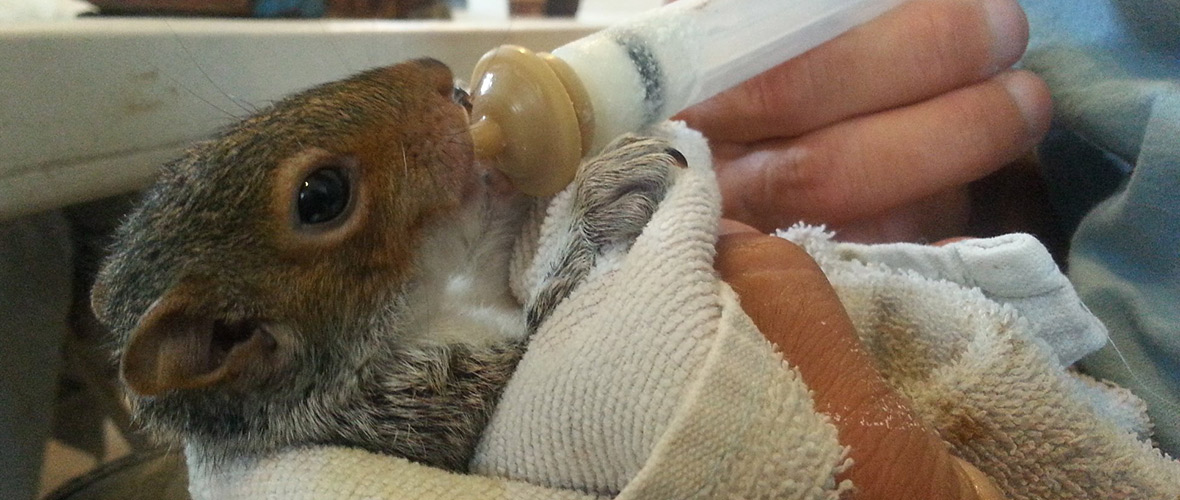Why a Humane Approach?
NOTE: In some specific cases, a wildlife control professional must trap the squirrel in a cage trap to remove it. This could involve cases in which a squirrel might persistently chew wood to re-enter an attic,
and thus mere exclusion is not an option. In most cases, the squirrel can be relocated without harm. In some states, the department of agriculture or department of wildlife will mandate that all rabies vector species, including
squirrels, be euthanized in as humane a manner as possible.
Is it important to treat squirrels humanely? Does such an approach compromise the speed or effectiveness of removing them from your home or attic? We believe that it's very important to remove squirrels humanely, and if you
do it correctly, a humane approach is also the most effective one.

Squirrels are sentient, intelligent creatures that are not only fun to watch, but are actually natural born gardeners, enriching the flora in any environment they inhabit by planting seeds which will grow to further sustain wildlife in the area. Our common tree squirrels will live their lives in a relentless survival mission, constantly in a race for food. Their food security goals are always reached, often through sophisticated new techniques and strenuous efforts, making this animal a highly adaptable forager, a great strategist, and an admirable problem-solver. And while people may have their fair reasons why they don’t want squirrels in their homes, there’s absolutely no need for cruel measures to be put in place in order to get rid of them.
In addition to all of these reasons why squirrels should be treated humanely, there are some other examples for your consideration. For instance, you don’t necessarily need to care about squirrels and the way they are treated to understand that poison is a horrific way of dealing with any invasive wildlife, including squirrels. If you’re trying to get rid of a squirrel that’s denning in your attic, you can be sure that that squirrel is raising a litter up there. Poisoning the squirrel will not only leave the animal to an agonizing slow death, but will also leave the offspring motherless and subject to the same regretful and premature ending. It’s that, or the litter gets poisoned as well, both scenarios in which you’re left with rotting squirrels carcasses, probably in a hard-to-access area. If poisoned, the animal will be weak and won’t be able to defend itself from predators as it normally does. If cached by a predator, you risk lethally poisoning a second animal, or at least making it suffer for a couple of days. Same with animals that feed on carcasses – death or intense suffering due to “second-hand” poisoning. Poisoning non-target animals and even children is always a risk with poison, on top of it being such a horrendous method of dealing with the situation. Lethal traps also fall into the unnecessarily cruel category, as squirrels are amazingly fast and have incredible reflexes, often escaping the trap with just an injury. That injury can become infected, infection which will slowly and painfully kill the animal, again, most likely leaving a litter behind. All this, on top of there not being any reason for killing squirrels in the first place, humanely or otherwise.
So, how can you deal with a squirrel infestation in a humane manner? First of all, if the squirrel is in your attic, you need to figure out if she has already given birth to her litter, and make your decision according to this fact. Baby squirrels should not be left to fend for themselves – which they won’t be capable of doing anyway – under any circumstances. Having said that, the most humane and efficient squirrel removal method is through using a one-way exclusion door. More information about how to use this method and all the variables you need to keep in mind while doing so can be found right here on this website, and you’re more than welcome to consult our humane removal DIY guides.
Fixing a squirrel problem never means exterminating the animal. It means that you need to stop luring the squirrel inside. It all comes down to prevention. Preventing squirrels from creating nests on your property calls for outdoor maintenance and habitat modification. Yards and gardens need to be kept free of fallen nuts or other fruits. Garbage cans need to be sanitized, secured, and kept indoors if the space permits. Pet food or livestock food should not be stored outside, or kept outside after the animals are done eating. Birdfeeders need to be installed away from trees, and properly equipped against squirrels. Home repairs must be performed. All open holes and other possible squirrel points of entry to the house need to be sealed shut with heavy steel mesh. The perimeter around a vegetable garden should be secured with a squirrel-proof fence. Woodpiles that are stored outside should also be surrounded by a fence, or at least sprayed with hot sauce. Tree branches should be kept at least 6 feet away from the roof.
You will find that on this website we’re all about the humane treatment of squirrels, and we invite you to join our little movement by personal example, if by nothing else. Truth be told, if we’ve convinced you or taught you how to deal with squirrels in a humane manner, and you end up using our suggested methods in dealing with your particular squirrel problem, it’s a win for everyone involved. If you choose to also further spread our message, even better. Feel free to contact us via email if you have any other questions regarding humane squirrel removal, and we’ll be happy to answer.
Go back to the Squirrels in the Attic home page to read more about Why Treat Squirrels Humanely - Humane Removal and Prevention Techniques.

